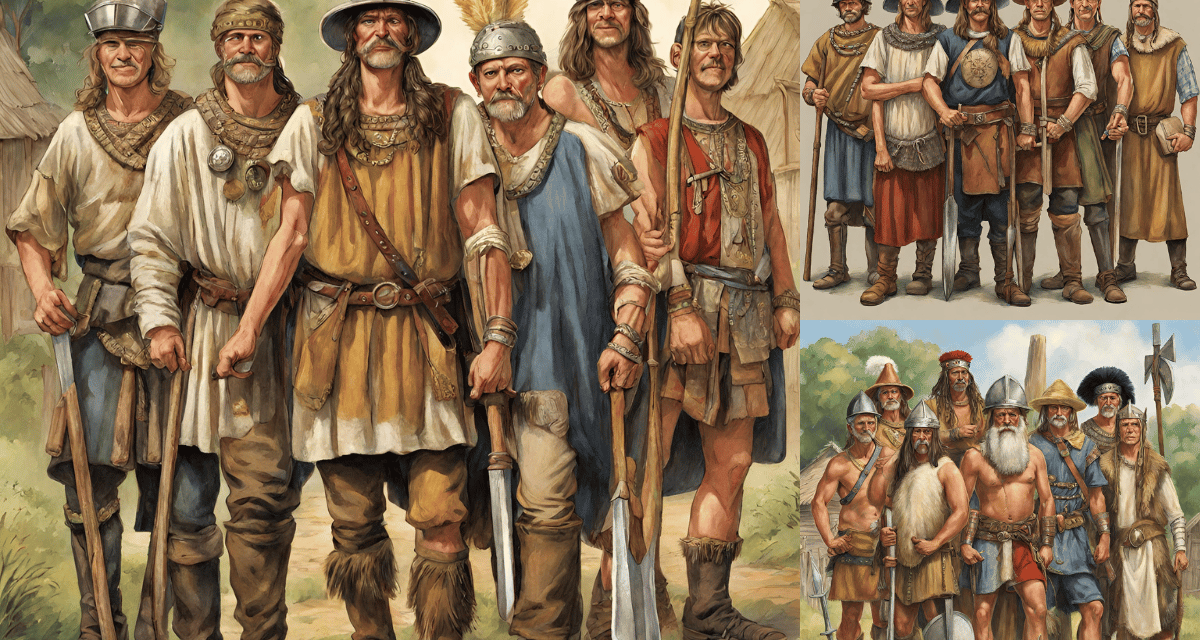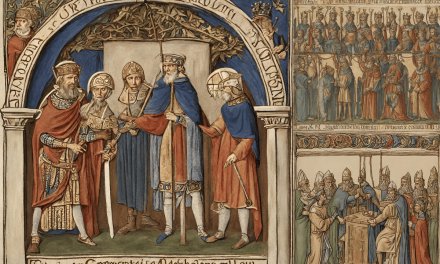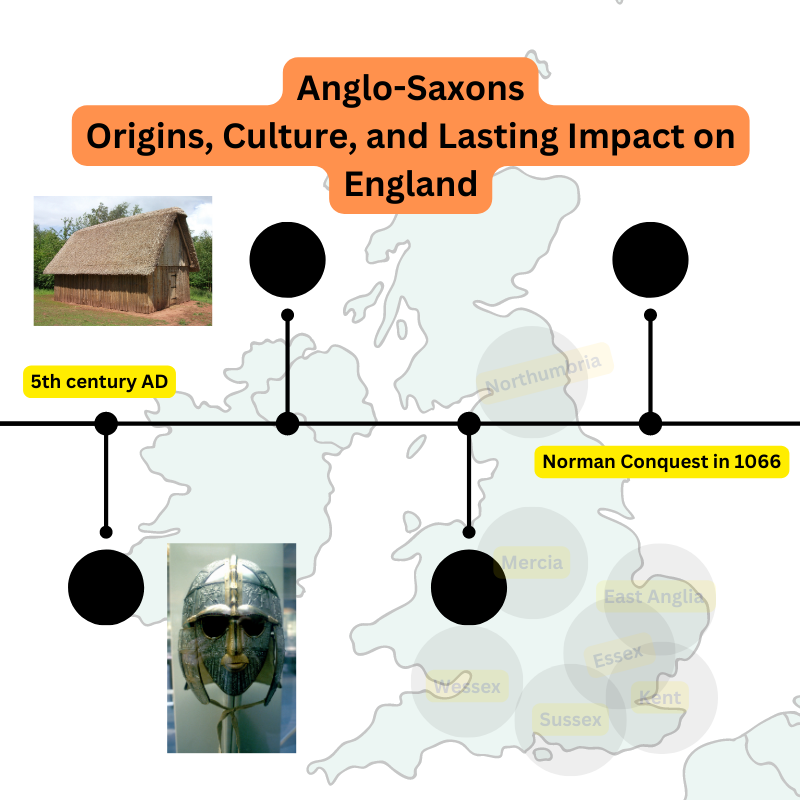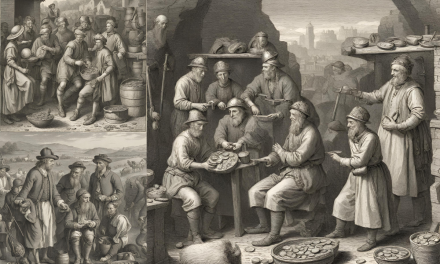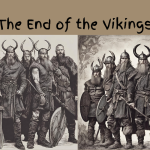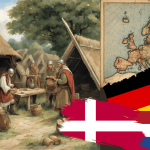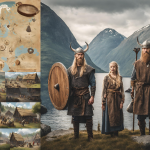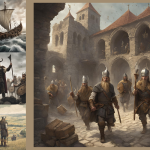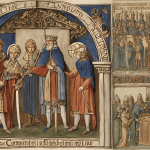The Anglo-Saxons came from three mighty Germanic tribes: the Saxons, the Jutes, and the Angles. These people originally came from Northern Germany, Denmark, and the Netherlands and traveled to the island of Britain in the 5th century. Vortigern conducted the immigration mainly to help him, as the British ruler, defend his Kingdom against the invasion of the Scots and Picts.
Now we know where the Anglo-Saxons came from. Let’s learn more about them, where they settled, and the language they spoke.
Anglo-Saxons Settlement Locations
Historical evidence suggests that Anglo-Saxons settled in the Eastern part of England. However, after some time, they started moving Northwards to occupy territory that indigenous British people formerly populated.
Even then, Wales was considered a British stronghold. Cumbria also held out against the onslaught of the invaders for a more extended period than any other part of northern England.
Historians present a wholesome picture of conflicts between the native British people and Anglo-Saxons in the early period. For example, Gildas suggested that the invasion of Anglo-Saxons was a punishment from the gods for the repulsive behaviour showcased by some British leaders.
Until the 10th century, Cornwall held up as long as possible against the invasion.
The Saxon kingdoms took hold in England’s Western and southern parts. For example, the Sussex area was named South Saxons, Middlesex was Middle Saxons, Essex area was East Saxons. The Angles kingdoms in Northern, Eastern, and Midland Britain were named East Anglia, Mercia, and Northumbria.
Why were Anglo-Saxons called Anglo-Saxons?
The name Anglo-Saxons were not representative of the people who invaded England during the middle ages. The term Anglo-Saxons were derived from it. The word came from the old English ethnonym “Angul-Seaxan”, a derivative of the Latin Angli-Saxones.
The English Monk Bede called these people Angli and Jutes, and the British Monk Gildas called them Saxons. In 786 AD, these two terms were used simultaneously as Anglo-Saxon when they met, dropping the Jutes as there were a much lesser tribe.
As we have mentioned earlier, the term Anglo-Saxon was rarely, if ever, used by the people belonging to this group. These people identified themselves using local or tribal names in most cases.
On the other hand, the Vikings started developing a Scandinavian identity in Danelaw. Historians of today generally use the term Anglo-Saxon as a short indicator for referring to the period between the Roman occupation of Britain and the Norman conquest of England.
Language
Learn about the Anglo-Saxons’ language and how some could speak many languages.
What was the language of Anglo-Saxon people?
The Anglo-Saxon people used to talk in a language that we identify today as old English. As the name suggests, old English is the grandfather of the English language we use today. The closest cousin of old English is other Germanic languages, like Old Norse, Old Frisian, and Old High German.
The manuscript from the Anglo-Saxon era that still lasts today showcases different dialects of old English that existed during that period. For example, the Mercian, West Saxon, and Northumbrian dialects were the most popular ones.
One of the oldest English poems, Cædmon’s Hymn, was written in the Northumbrian dialect of Old English.
However, A handful of Anglo-Saxon individuals could speak and understand several other languages. The Latin, Irish, Cornish, and Greek languages were also quite popular. Among these three, Irish was the language that many early missionaries used.
From 793 AD, when the Viking invasion started in England, they spoke Old Norse, also known as Old Nordic or Old Scandinavian, in various parts of eastern and northern England. The traces of Old Norse can still be seen in some of the names of different places. For example, the name York came from its original Scandinavian word Jorvik.
Literacy
Anglo-Saxons wrote books and were able to read and write. Many children went to school. However, the children who didn’t go to church schools often helped out around the house or land with their families.
Historians have found about 1000’s books owned or written in England before 1066 AD. Apart from that, several Anglo-Saxon charters that survived the test of time have also been found by historians.
Charters are documents of grants of land or recorded privileges.
Some of the books found were manuscripts created for religious purposes, monastic records, and biographies of saints are some of the classic texts of the Anglo-Saxon period.
The surviving manuscript of Beowulf is considered to be one of the greatest poems from the Anglo-Saxon period, which was created around 1000 AD.
Read the Beowulf poem here, translated into modern English.
Were Anglo-Saxons more clever than the Romans?
They could read and write better than the Romans. Many Romans couldn’t write, but some Anglo-Saxon children could because they went to school and were educated by monks in churches.
Who else lived in England at the same time as the Anglo-Saxons?
The Vikings did this from 790 AD until 1066 AD. They fought with many Anglo-Saxons over land and broke up areas they held for themselves during this time.
When was the end of the Anglo-Saxon and Viking eras?
The Anglo-Saxons and the Vikings were the two groups of people who ruled over England, Wales and Scotland. This lasted until 1066 AD when William the Conqueror won a battle against King Harold II. After that, the medieval era began.
Who was the last Anglo-Saxon English king?
- King Harold II
Harold Godwinson was the last crowned Anglo-Saxon English king. He ruled from 6 January 1066 until he died in a battle against the Norman invaders at The Battle of Hastings on 14 October 1066, led by William the Conqueror.
Who ruled England before King Harold II?
Edward the Confessor was the King of England before King Harold II. His coronation was on 3 April 1043. Edward the Confessor died on 5 January 1066, aged in his early 60’s. A day later, after the death of Edward the Confessor, King Harold II had his coronation and became the King of England.
Were Anglo-Saxons Vikings?
No, Anglo-Saxons were not Vikings. Vikings and Saxons are two different Tribes of people. Both groups of people were Germanic and had many similarities, but they were not the same.
Where did the Vikings come from?
The Vikings originated from areas we now refer to as Denmark, Sweden and Norway.
Who Came First: The Anglo-Saxons or The Vikings?
The Anglo-Saxons migrated to England at the beginning of the fifth century, 410 AD, when the country was still under Roman control. Vikings started invading England in the 8th century, 793 AD.
When was the first recorded Viking attack?
On 8 June 793 AD, the Vikings attacked a church in Lindisfarne and killed several people brutally.
While Vikings were known for brutality, many settled in England and became faithful Christians.
What was the religious belief of Anglo-Saxon people?
The Anglo-Saxon people that first settled down in England were mainly pagans. The insight about their religious practices comes from their burial practices or the text written by Christian missionaries.
The excavation of the grounds of the Anglo-Saxon people has shown that pagan Anglo-Saxons preferred cremation over burials.
However, sometimes they used to bury their dead and grave goods. Adding items to burial strongly indicates that the early Anglo-Saxon people were believers in the Afterlife.
Is the British people’s DNA Anglo-Saxon?
British DNA mixes many ethnicities, including Anglo-Saxon, Celtic, Viking, and Norman.
How much of Saxon’s DNA does the UK have today?
It is estimated that around 10-20% of the UK population has Anglo-Saxon DNA.

